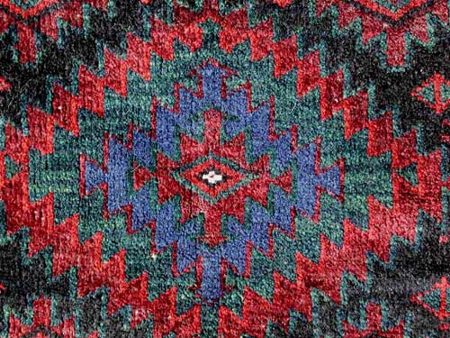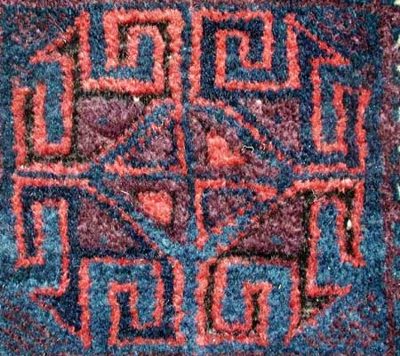
The Salon du Tapis d'Orient is a moderated discussion group in the manner of the 19th century salon devoted to oriental rugs and textiles and all aspects of their appreciation. Please include your full name and e-mail address in your posting.
by Thomas Cole
I
In HALI #97, I wrote an article entitled Baluch Aesthetics. Ostensibly, this article was intended as a postscript to the interview with Jerry Anderson which appeared in HALI #76. The interview with Jerry took place under the harshest and most disconcerting of conditions. The information he gave me over the course of two days made absolutely no sense at all as I listened to him in the midst of the squalor in which he lived at that time. In spite of his obvious poverty though, Baluch tribal leaders and obviously influential people came to visit him as he shared his time with me over those two days so long ago. In any case, it was only after returning to my hotel and listening to the tapes out of context, with neither he or any rugs around, did I realize there was something on the tapes of value.
But the specific tribal attributions remained a source of debate and controversy, subject to opinions and conjecture with little foundation, from our point of view here in the West. Clearly the array of tribal names that had been offered in the past were a source of confusion, rather than representing a real source of comfort for either dealers or collectors.
Upon further reflection, provenance seemed to be a much more relevant as well as more easily understood manner in which to categorize these rugs. Colour, the use of colour, became the primary criterion by which I judged the provenance of SOME pieces, making a distinction in the use of red between Khorassan and W. Afghanistan in addition to iconography and weave. The presence of a dynamic palette characterized by greens, blue/green in addition to aubergine and red is apparently a distinctive feature of some rugs from SE Persia otherwise known as Seistan.
Contrary to the general public perception, Baluch rugs CAN
and DO have colour. The ACOR exhibition of Baluch rugs was dedicated
to Baluch rugs WITH colour, a stated goal of the exhibition. It
is just a matter of finding those that do and settling for nothing less. The
dealer will offer what he has but the collector has a choice to make. I
have never heard anyone in any rug field discuss the variations in the
use of or the presence of BROWN, but when one looks through the plethora
of rugs and weavings residing in collections, for sale by dealers on the
internet, etc., brown (camel wool, brown red, etc.) appears to be
the colour of choice. This first example is distinctly brown with
limited use of colour.

The use of a camel ground field does not preclude the use of color or a colorful palette as exhibited in this second images.

The geographic proximity of Khorrasan to Turkmenistan accounts for the use of a more brilliant red than seen in many of the Afghan Baluch weavings. A clear, truly RED madder red is an attribute of the Khorassan production. Lesser reds from this region apparently might be the result of either poor dye preparation skills and/or bad water or limited access to the correct madder root plant. Here we see two distinctly different reds or use of red, with the Afghan example exhibiting a warmer red, with more yellow components integrated into the red colour, as contrasted with these two Khorassan examples. Some of the reds in the Khorassan pieces appear to have an almost magenta shading to them as well as the classic Khorassan orange/red which dominates the palette of these weavings.



From madder, many different shades of colour may be obtained, including purple (aubergine), orange, etc. The brown reds which appear often in Baluch rugs may be more a product of an inexpertise in dyeing than anything else as seen in this next photograph.

Indigo would seem to be a 'safe' dye to use, with similar, consistent results. It is imported from India, and seemingly of similar quality. But the blues seen in Baluch rugs certainly vary. The preparation of indigo is a longer process than required with some dyes and here the expertise, or lack thereof, becomes more evident. Please refer to the previous photograph as compared to the blues seen in this next piece, an example from SW Afghanistan.

I have fielded more than a few questions regarding the greens seen in Seistan area weavings. Some people were concerned that green is a late feature in Baluch weavings. It is difficult for me to imagine from where that idea came, but clearly the presence of green is not a late feature. This next photo clearly shows the range of colour seen in old weavings from the Seistan region of Persia, a delicately handled palette of beauty.

On the contrary, the colour contrast seen in Seistan area weavings (and most
other Baluch weavings) disappears in later pieces. A murkier
palette emerges, with blues, reds and greens merging into a darker appearance, without
the lighter, contrasting tones which can make Baluch weavings beautiful. This
next photo is not of the latest type of Baluch weaving
from this region but clearly shows a lack of colour which one normally associates
with the Seistan Baluch groups. The second photo is more illustrative of this concept of a late palette with little colour contrast.

This next image depicts another Seistan region weaving, again with nice green but a decidedly less interesting palette with a more brown red and a preponderance of camel wool. If this weaving had a clear madder red, it would be so much more appealing.

This idea of late weavings assuming a darker, murkier appearance is easily illustrated in the Arab Baluch rugs. The monochromatic appearance of later pieces is contrasted sharply with a more vibrant colourful palette of an earlier example.


Following are two photos which graphically illustrate the differences in palettes
between Khorassan Baluch and some Afghan Baluch groups. The weavings
depict similar motifs, the first photo is a detail taken from a Doktor-I-Qazi
prayer rug, while the second image is taken from an Afghan Baluch blue ground prayer rug, often referred to as Timuri group in the
marketplace. Note the extreme difference in the use of colour. Even
though the Khorassan piece is a very fine weave and ostensibly a very expensive
rug given the nature of the design (Doktor-i-Qazi) and weave, the Afghan
example is colourful and pretty. The crowded drawing and stiff , mechanical
quality of the design in the Khorassan weaving are also features that are
not especially
attractive to my eye.


One group I have failed to discuss is the so-called "Bahlul" group of Baluch weavings. This group is characterized by the use of the symmetric knot and is often seen with a 'hot' red. Clearly these examples are later but it is probable the Bahlul group embraced the use of a synthetic red earlier than others, possibly due to accelerated access to it through trade routes, etc. Following is a detail of one of these rugs which does NOT have the synthetic red. Clearly their penchant for a bright red (possibly a red mordanted with tin?) may account for the use of synthetic red, a shade favoured by their aesthetic sensibilities.

It is interesting to note that NONE of these examples are "museum" pieces, illustrative of the fact that they're representative of rugs available in the marketplace.
Now, for an exercise that may prove useful. Let us 'guess' from where the following rugs come, and discuss the aesthetics that we see in these detail images. All rugs are woven with an asymmetric knot open to the left.
Number 1: 
Number 2: 
Number 3: 
Number 4: 
Number 5: 
Number 6: 
Number 7: 
Number 8: 
Number 9: 
Number 10: 
Number 11: 
Number 12: 